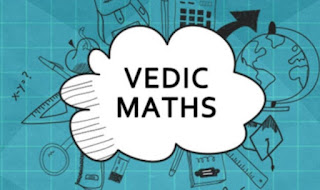VEDIC MATHS-63
VEDIC MATHS
By OMKAR TENDOLKAR
This is post number 63 from the series of "Vedic maths" blogs. Here in this blog we will learn about "The Osculation Method for checking divisibility of number by Positive Osculator"
Concept of Osculator :
The concept of ‘Osculator’ is useful to check the divisibility of a given number by divisors ending with 9 or 1 or a multiple there of.
An osculator is a number defined for any number ending in 9 or 1 and is obtained from the number by a simple mechanism described in this chapter.
The use of osculators would be severely limited if only these two categories of numbers viz. ending with 9 or 1 were considered. Interestingly, numbers ending with 3 and 7 can also converted to numbers ending with 1 or 9 by a suitable multiplication. The same techniques can be used for all such numbers too.
Osculators are categorized into two main types viz. positive and negative depending on whether the number ends with 9 or with 1.
- Dropping 9
- Adding 1 to the remaining number
This method will help us find the divisibility rule for any number.
Examples :
1. Check whether 112 is divisible by 7 or not.
Again we find the Positive Osculator of 7.
- Here, given number 7 end with 7, we can multiply it by 7, to convert it to a number which ends in 9 i.e. 49.
- Dropping 9
- Adding 1 to remaining digit i.e. 4 gives 5.
Positive Osculator of 7 is 5.
Now we osculate 112 with 5.
To osculate a number, we multiply its last figure by the Osculator of the divisor (it is 7 here) and add the result to its previous figure.
So, say we have 112.
11 + (2 × 5)
= 11 + 10
= 21
Now we osculate again. We multiply 1 by 5 and add to 2.
= 2 + (1 × 5) = 7
Since our osculation result is the divisor itself (7), we can clearly say that 112 is divisible by 7.
Answer :2. Check whether 49 is divisible by 7 or not.
Again we find the Positive Osculator of 7.
- Here, given number 7 end with 7, we can multiply it by 7, to convert it to a number which ends in 9 i.e. 49.
- Dropping 9
- Adding 1 to remaining digit i.e. 4 gives 5.
Positive Osculator of 7 is 5.
We now osculate 49 with 5.
To osculate a number, we multiply its last figure by the Osculator of the divisor (it is 7 here) and add the result to its previous figure.
= 4 + (9 × 5)
= 49
Now we osculate again. We multiply 9 by 5 and add to 4.
= 4 + (9 × 5)
= 49
We see that there is a repetition of 49 as we osculate. And, whenever we osculate, we will see that only multiples of 7 are produced. And osculating any number which is not a multiple of 7 will never produce a multiple of 7.
This means 49 is divisible by 7.
Answer :3. Check whether 844 is divisible by 79 or not.
We first find the Positive Osculator of 79
- Dropping 9
- Adding 1 to remaining digit i.e. 7 gives 8.
Positive Osculator of 79 is 8.
We now osculate 2844 with 8
To osculate a number, we multiply its last figure by the Osculator of the divisor (it is 8 here) and add the result to its previous figure.
284 + (4 × 8)
= 284 + 32
= 316
Now we osculate again. We multiply 6 by 8 and add to 31.
= 31 + (6 × 8)
= 31 + 48
= 79
Since our osculation result is the divisor itself (79), we can clearly say that 2844 is divisible by 79.
4. Check whether 1035 divisible by 23 or not.
We first find the Positive Osculator of 23
- Here, given number 23 end with 3, we can multiply it by 3, to convert it to a number which ends in 9 i.e. 69
- Dropping 9
- Adding 1 to remaining digit i.e. 6 gives 7.
Positive Osculator of 23 is 7.
We now osculate 1035 with 7
To osculate a number, we multiply its last figure by the Osculator of the divisor (it is 7 here) and add the result to its previous figure.
= 103 + (5 × 7)
= 138
Now we osculate again. We multiply 8 by 7 and add to 13.
= 13 + (8 × 7)
= 13 + 56
= 69
Now we osculate again. We multiply 9 by 7 and add to 6.
= 6 + (9 × 7)
= 69
We see that 69 is repeating. 69 is the multiple of 23. So we can safely say that 1035 is divisible by 23.
5. Check whether 3588 is divisible by 69 or not.
We first find the Positive Osculator of 69
- Dropping 9
- Adding 1 to remaining digit i.e. 6 gives 7.
Positive Osculator of 69 is 7.
We now osculate 3588 with 7.
To osculate a number, we multiply its last figure by the Osculator of the divisor (it is 7 here) and add the result to its previous figure.
= 358 + (8 × 7)
= 414
Now we osculate again. We multiply 4 by 7 and add to 41
= 41 + (4 × 7)
= 69
Since we got 69 after the osculation process and it is also our divisor, we can safely say that 3588 is divisible by 69.
In next blog we will discuss about "Concept of Negative Osculator".
We will meet very soon through our next blog. Till that stay connected, stay healthy and stay safe.
Thanks
for giving your valuable time.


Comments
Post a Comment